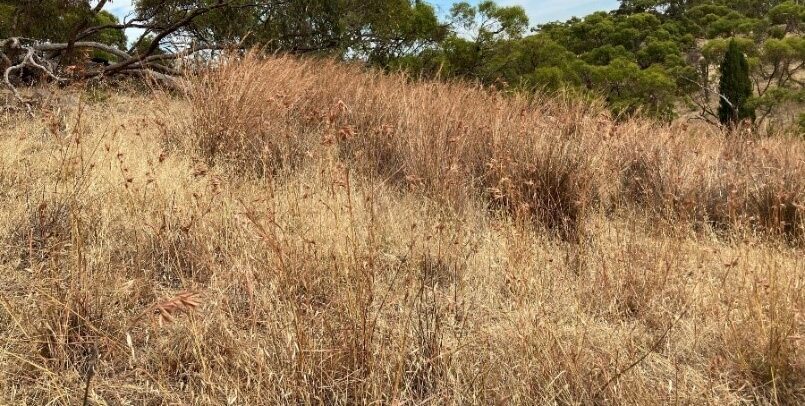Coolatai grass is a highly invasive, large clumping grass weed of pastures, native grasslands and grassy woodlands.
Description
Coolatai grass (Hyparrhenia hirta) is a dense perennial (occurring year to year) tussock (clumping) grass growing on average up to 1m but can reach up to 1.5m high. It has thin grey-green leaves to 30cm long and 0.5cm wide.
Its flowers are grey-white silky spikes, which grow in pairs, forming a 'v' shape at the end of their stalks.
This weed has the capacity to produce vast quantities of seed over different seasons but mostly through autumn and spring. The small grain like seeds, 2mm long, have awns (tails) attached. Seed germinates easily, with plants growing in a wide temperature range and on a range of soil types.
It has a rapid colonisation rate and an ability to persist under heavy grazing and burning.
It is mostly a summer active plant occurring when there are moist conditions, but in the Green Adelaide region it is not active during Adelaide's hot dry summers, and dormant through the cold of winter. It is most active during autumn and spring. After seasonal dormancy it readily re-sprouts from the tough base and responds well to summer rainfall.

Impacts
Coolatai grass threatens native grasslands and grassy woodlands in southern Australia. It forms dense monocultures that smoother and displaces native plants and reduces quality of fauna habitat.
Tall plants also become rank and unpalatable to stock. It produces large amounts of dry material increasing fuel load and fire risk, and impacts on grazing land by dominating paddocks left idle or only lightly grazed.
Similar species
Young plants may appear similar to some native grass species, with the most common resembling Coolatai grass being kangaroo grass (Themeda triandra).
If you are unsure about correctly identifying the pest plant, it might be best to wait until it flowers to ensure you are controlling the weed and not the native.


Distribution
Native to Africa, Coolatai grass was introduced in the 1890s to a town of NSW where it got its name, for erosion control.
Used as a landscaping plant in the 1990s in northern Adelaide, it quickly invaded and established into nearby foothill escarpments, native reserves and former grazing land and vacant urban and industrial blocks.
Although a few populations have also been recorded in other regions, the main infestations of Green Adelaide are found along the northern escarpments.
Spread only by seed, this is assisted by wind, water, slashing and attachment to animals, clothing and vehicles.
Control
Coolatai grass is a declared and notifiable weed under the Landscape South Australia Act 2019. The sale of Coolatai grass or contaminated goods; and its movement on a public road are prohibited. It is the responsibility of the land owner to control these plants on their property.
We encourage the control of Coolatai grass where there is a risk to biodiversity assets.

Control methods
Hygiene
Help prevent and restrict the spread of Coolatai grass by avoiding work in infested areas unless you’re controlling the plant.
Decontaminate machinery, stock or clothing of any seed before you leave an infested area.
Hand weeding/chipping
This technique is suitable for isolated plants or small patches and at any time of the year. Grub plants out by cutting roots below the tussock base.
If no seed heads are present, you can leave them onsite to decompose.
If seed heads are present, cut and double bag them, secure with tape for disposal in the general waste bin and leave the rest of the plant on the ground. Or leave the seed heads on and stockpile the plants onsite to compost and where they can be easily monitored long term for new germinations to be controlled.
Chemical
Application is the most important part: apply the herbicide to all leaf surfaces to the point of runoff. Most effective while plants are actively growing during autumn and spring.
Targeted spraying
This method is best for small to medium sized populations and where you can access all plants in a patch or individual and outlier plants.
Edge spray control
Used to control the spread of large dense populations where access to all plants is restricted.
The aim is for containment alongside efforts to eradicate and control outlier and smaller populations.
Spray herbicide on plants at the edge of the weed front that are easily reached.
Spray post burn or post cut
For use over large areas. Some success has been observed where tussocks have been carefully cut with a bladed whipper snipper, tractor slashed or patches burnt to remove the bulk of the biomass. Then new growth is sprayed with herbicide.
This uses less herbicide and ensures better coverage and access across the whole patch.
Monitor and follow up control
Treated areas should be monitored 3-4 times a year to check for new growth and to control plants before they set seed.
Optimum timing is when most new seedlings are out and before flowering.
For advice on chemical options go to PIRSA's Identifying declared weeds.
Observations of weeds can be entered into iNaturalist, an app which can assist with identification of species.